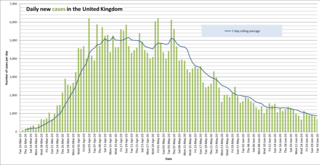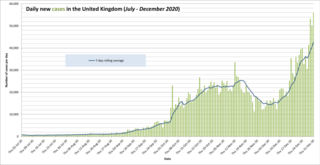Related Research Articles

In public health, contact tracing is the process of identifying persons who may have been exposed to an infected person ("contacts") and subsequent collection of further data to assess transmission. By tracing the contacts of infected individuals, testing them for infection, and isolating or treating the infected, this public health tool aims to reduce infections in the population. In addition to infection control, contact tracing serves as a means to identify high-risk and medically vulnerable populations who might be exposed to infection and facilitate appropriate medical care. In doing so, public health officials utilize contact tracing to conduct disease surveillance and prevent outbreaks. In cases of diseases of uncertain infectious potential, contact tracing is also sometimes performed to learn about disease characteristics, including infectiousness. Contact tracing is not always the most efficient method of addressing infectious disease. In areas of high disease prevalence, screening or focused testing may be more cost-effective.

The COVID-19 pandemic in the United Kingdom is a part of the worldwide pandemic of coronavirus disease 2019 (COVID-19) caused by severe acute respiratory syndrome coronavirus 2 (SARS-CoV-2). In the United Kingdom, it has resulted in 24,779,150 confirmed cases, and is associated with 230,383 deaths.

The COVID-19 pandemic in Scotland is part of the COVID-19 pandemic of coronavirus disease-2019, caused by the virus SARS-CoV-2. The first case of COVID-19 was confirmed in Scotland on 1 March 2020. Community transmission was first reported on 11 March 2020, and the first confirmed death was on 13 March 2020.

Operation Rescript was the code name for the British military operation to help tackle the COVID-19 pandemic in the United Kingdom and its Crown Dependencies between 2020 and 2022. It was described as the UK's "biggest ever homeland military operation in peacetime" by the Ministry of Defence (MOD), involving up to 23,000 personnel within a specialist task force, named the COVID Support Force (CSF). The support was given at the request of the UK government, its devolved administrations and civil authorities through the Military aid to the civil authorities (MACA) mechanism.

The COVID-19 pandemic was confirmed to have spread to Wales on 28 February 2020, with a case being reported in the Swansea area; this first known case was a person who had recently returned from Italy. The first known case of community transmission was reported on 11 March in the Caerphilly area.

COVID-19 surveillance involves monitoring the spread of the coronavirus disease in order to establish the patterns of disease progression. The World Health Organization (WHO) recommends active surveillance, with focus of case finding, testing and contact tracing in all transmission scenarios. COVID-19 surveillance is expected to monitor epidemiological trends, rapidly detect new cases, and based on this information, provide epidemiological information to conduct risk assessment and guide disease preparedness.

COVID-19 apps include mobile-software applications for digital contact-tracing - i.e. the process of identifying persons ("contacts") who may have been in contact with an infected individual - deployed during the COVID-19 pandemic.

In response to the COVID-19 pandemic in the United Kingdom, the UK Government introduced various public health and economic measures to mitigate its impact. Devolution meant that the four nations' administrative responses to the pandemic differed; the Scottish Government, the Welsh Government, and the Northern Ireland Executive produced different policies to those that apply in England. Numerous laws were enacted or introduced throughout the crisis.

The following is a timeline of the COVID-19 pandemic in the United Kingdom from January 2020 to June 2020.

The (Google/Apple) Exposure Notification (GAEN) system, originally known as the Privacy-Preserving Contact Tracing Project, is a framework and protocol specification developed by Apple Inc. and Google to facilitate digital contact tracing during the COVID-19 pandemic. When used by health authorities, it augments more traditional contact tracing techniques by automatically logging close approaches among notification system users using Android or iOS smartphones. Exposure Notification is a decentralized reporting protocol built on a combination of Bluetooth Low Energy technology and privacy-preserving cryptography. It is an opt-in feature within COVID-19 apps developed and published by authorized health authorities. Unveiled on April 10, 2020, it was made available on iOS on May 20, 2020 as part of the iOS 13.5 update and on December 14, 2020 as part of the iOS 12.5 update for older iPhones. On Android, it was added to devices via a Google Play Services update, supporting all versions since Android Marshmallow.

NHS COVID-19 was a voluntary contact tracing app for monitoring the spread of the COVID-19 pandemic in England and Wales. It had been available since 24 September 2020 for Android and iOS smartphones, and can be used by anyone aged 16 or over.

NHS Test and Trace is a government-funded service in England, established in 2020 to track and help prevent the spread of COVID-19. Despite its name, the programme was never in fact run by the NHS: the programme is part of the UK Health Security Agency; the service and the agency are headed by Jenny Harries.
The following is a timeline of the COVID-19 pandemic in Scotland during 2020. There are significant differences in the legislation and the reporting between the countries of the UK: England, Scotland, Northern Ireland, and Wales.
The following is a timeline of the COVID-19 pandemic in England from January 2020 to June 2020. There are significant differences in the legislation and the reporting between the countries of the UK: England, Scotland, Northern Ireland, and Wales.

The following is a timeline of the COVID-19 pandemic in the United Kingdom from July 2020 to December 2020.
The following is a timeline of the COVID-19 pandemic in England from July 2020 to December 2020. There are significant differences in the legislation and the reporting between the countries of the UK: England, Scotland, Northern Ireland, and Wales.

The following is a timeline of the COVID-19 pandemic in the United Kingdom from July 2021 to December 2021.

The United Kingdom's response to the COVID-19 pandemic consists of various measures by the healthcare community, the British and devolved governments, the military and the research sector.

This article outlines the history of the COVID-19 pandemic in the United Kingdom. Though later reporting indicated that there may have been some cases dating from late 2019, COVID-19 was confirmed to be spreading in the UK by the end of January 2020. The country was initially relatively slow implementing restrictions but a legally enforced stay-at-home order had been introduced by late March. Restrictions were steadily eased across the UK in late spring and early summer that year.
The following is a timeline of the COVID-19 pandemic in the United Kingdom in 2023.
References
- ↑ "Public Health Wales Implementation Plan". Welsh Government. Retrieved 24 September 2022.
- ↑ "Test, trace, protect: coronavirus". phw.nhs.wales. NHS Wales and PHW. Retrieved 13 February 2021.
- ↑ "New Welsh Government plan for coronavirus testing has been announced after a deal to provide an extra 5,000 tests a day with a supplier collapsed". BBC News. 28 March 2020. Retrieved 26 April 2021.
- ↑ "'Collapsed' Roche testing deal correspondence withheld". BBC. 9 June 2020. Retrieved 26 April 2021.
- ↑ "Health boss claims Covid-19 tests were 'intercepted' for England in bombshell email". Nation Wales. 26 April 2021. Retrieved 26 April 2021.
- 1 2 "Covid tests clearly prioritised for England, Public Health Wales boss claimed in email". BBC. 26 April 2021. Retrieved 26 April 2021.
- ↑ "Getting tested for coronavirus (COVID-19)". Welsh Government. Retrieved 13 February 2021.
- ↑ "Loughborough Lighthouse Lab creates 400 jobs and plans to process 50,000 Covid-19 tests a day". www.leicestermercury.co.uk. 30 November 2020. Retrieved 30 November 2020.
- ↑ "App Data Protection Impact Assessment" (PDF). Public Health Wales. Retrieved 13 February 2021.
- ↑ "Wales' Test, Trace, Protect Strategy" (PDF). UNISON. Retrieved 13 February 2021.
- ↑ "Guidance on protecting people defined on medical grounds as clinically extremely vulnerable from coronavirus". Welsh Government. Retrieved 13 February 2021.
- ↑ McCormack, Jayne (23 April 2020). "Contact tracing pilot to start in NI next week". BBC News.
- ↑ McCormack, Jayne (19 May 2020). "Executive will 'revisit indoor family meetings'". BBC News. Archived from the original on 27 May 2020. Retrieved 28 May 2020.
- ↑ "Covid-19 tracing app is released in NI". BBC News. 30 July 2020.
- ↑ "NI Covid-19 app won't work on older iPhones". BBC News. 31 July 2020.
- ↑ "Scotland's Test and Protect: How it works". BBC News. 26 May 2020. Archived from the original on 26 May 2020. Retrieved 29 May 2020.
- ↑ Flockhart, Gary (11 September 2020). "Protect Scotland: New contact tracing app downloaded half a million times". The Scotsman. Retrieved 11 September 2020.
- ↑ "Test & Protect". Protect Scotland. Retrieved 11 September 2020.
- ↑ McCormack, Jayne (23 April 2020). "Contact tracing pilot to start in NI next week". BBC News.




